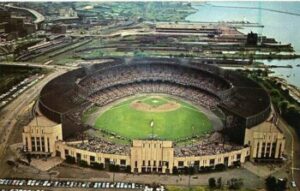July 31, 1932 – The grand opening of Cleveland’s Municipal Stadium took place. The Cleveland Indians christened their new home, in front of more than 76,000 fans. However, the Tribe lost the first game in their new confines, 1-0 to the Philadelphia A’s.
The venue served the franchise as their home from 1932 through the 1993 season. It was also the home to the NFL’s Cleveland Browns and even the Cleveland Rams from 1935 through 1945. Cleveland Stadium, commonly known as Municipal Stadium, Lakefront Stadium was built in the downtown portion of the City near the Lake Erie WaterFront.
Before 1932 the Indians played their games at nearby League Park. In fact from 1932 to 1946 their home games were split between the two venues. In 1994 the Cleveland AL franchise moved into nearby Jacobs Field, which is now called Progressive Field.
To find more great daily sports history make sure to check out the Sports Jersey Dispatch and Pigskin Dispatch.

More From Sports History Network

Bracket Busters: Upsets to Watch in March Madness
As the calendar flips to March, college basketball fans brace themselves for the annual

The Story of the 1967 Los Angeles Rams
From 1956 to 1965, the LA Rams were not a good football team, posting

Great Wide Receivers From The 70s Before the 1978 Rule Change
Pro football has provided a showcase for the many different wide receivers who buckled

In The Beginning: An Interview With Joseph T. Sternaman
And, you may ask, who is Joseph T. Sternaman? Sternaman was more commonly known

Michael Jordan: Domination Through March Madness
Widely regarded as the greatest basketball player ever, Michael Jordan first captivated fans across

Triumph and Tragedy: The 1936 Olympics in Berlin
In the annals of Olympic history, few editions have been as impactful and controversial

The Most Bet On Sports Throughout History
Sports betting has been one of the world’s favorite activities for as long as

The Pine Tar Incident: George Brett’s Legendary Home Run
The Pine Tar Game stands as a monumental moment in baseball history, encapsulating the